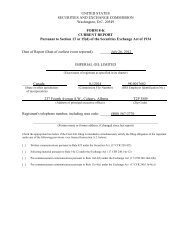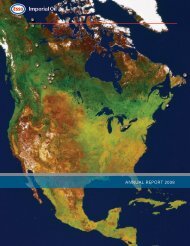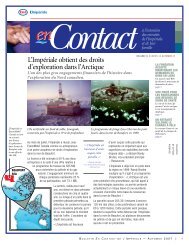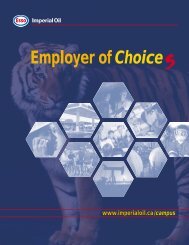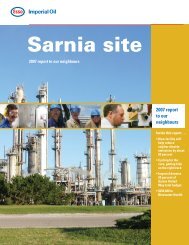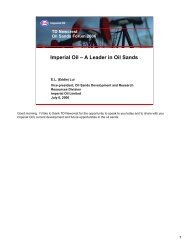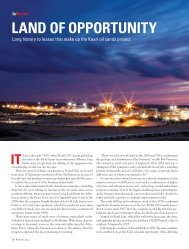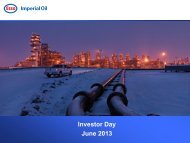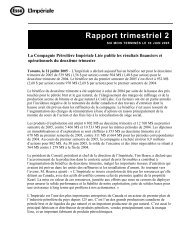FORM 10-K IMPERIAL OIL LIMITED
FORM 10-K IMPERIAL OIL LIMITED
FORM 10-K IMPERIAL OIL LIMITED
You also want an ePaper? Increase the reach of your titles
YUMPU automatically turns print PDFs into web optimized ePapers that Google loves.
Chemicals<br />
The Company’s Chemicals operations manufacture and market ethylene, benzene, aromatic and<br />
aliphatic solvents, plasticizer intermediates and polyethylene resin. Its major petrochemical and polyethylene<br />
manufacturing operations are located in Sarnia, Ontario, adjacent to the Company’s petroleum refinery.<br />
There is also a heptene and octene plant located in Dartmouth, Nova Scotia.<br />
The Company’s average daily sales of petrochemicals during the five years ended December 31, 2004,<br />
were as follows:<br />
2004 2003 2002 2001 2000<br />
(thousands a day)<br />
Petrochemicals:<br />
Tonnes............................................................. 3.3 3.3 3.5 3.3 3.1<br />
Tons................................................................ 3.6 3.6 3.9 3.6 3.4<br />
Research<br />
In 2004, the Company’s research expenditures in Canada, before deduction of investment tax credits,<br />
were $40 million, as compared with $36 million in 2003 and $50 million in 2002. Those funds were used<br />
mainly for developing improved heavy crude oil recovery methods and better lubricants.<br />
A research facility to support the Company’s natural resources operations is located in Calgary, Alberta.<br />
Research in these laboratories is aimed at developing new technology for the production and processing<br />
of crude bitumen. About 40 people were involved in this type of research in 2004. The Company also<br />
participated in bitumen recovery and processing research for tar sands development through its interest in<br />
Syncrude, which maintains research facilities in Edmonton, Alberta and through research arrangements with<br />
others.<br />
In Company laboratories in Sarnia, Ontario, research is mainly conducted on the development and<br />
improvement of lubricants and fuels. About 120 people were employed in this type of research at the end<br />
of 2004. Also in Sarnia, there are about 15 people engaged in new product development for the Company’s<br />
and Exxon Mobil Corporation’s polyethylene injection and rotational molding businesses.<br />
The Company has scientific research agreements with affiliates of Exxon Mobil Corporation which<br />
provide for technical and engineering work to be performed by all parties, the exchange of technical<br />
information and the assignment and licensing of patents and patent rights. These agreements provide<br />
mutual access to scientific and operating data related to nearly every phase of the petroleum and<br />
petrochemical operations of the parties.<br />
Environmental Protection<br />
The Company is concerned with and active in protecting the environment in connection with its various<br />
operations. The Company works in cooperation with government agencies and industry associations to deal<br />
with existing and to anticipate potential environmental protection issues. In the past five years, the Company<br />
has spent about $825 million on environmental protection and facilities. In 2004, the Company’s capital<br />
expenditures relating to environmental protection totaled approximately $130 million, and are expected to<br />
be about $350 million in 2005. The increased environmental expenditures over the past three years primarily<br />
reflect spending on two major projects. One project completed in 2004, costing $600 million, reduced<br />
sulphur in motor gasolines, meeting a requirement of the Government of Canada a year in advance. The<br />
second project underway in 2004 is to meet a new Government of Canada regulation requiring ultra-low<br />
sulphur on-road diesel fuel commencing in 2006 and which is to be fully implemented in 2007. In 2004,<br />
there were capital expenditures of about $90 million on this second project, which is expected to cost about<br />
$500 million when completed. Capital expenditures on safety related projects in 2004 were approximately<br />
$20 million.<br />
Human Resources<br />
At December 31, 2004, the Company employed full-time approximately 6,<strong>10</strong>0 persons compared with<br />
about 6,300 at the end of 2003 and 6,500 at the end of 2002. About eight percent of those employees<br />
are members of unions. The Company continues to maintain a broad range of benefits, including illness,<br />
disability and survivor benefits, a savings plan and pension plan.<br />
Competition<br />
The Canadian petroleum, natural gas and chemical industries are highly competitive. Competition includes<br />
the search for and development of new sources of supply, the construction and operation of crude<br />
oil and refined products pipelines and the refining, distribution and marketing of petroleum products and<br />
chemicals. The petroleum industry also competes with other industries in supplying energy, fuel and other<br />
needs of consumers.<br />
13



